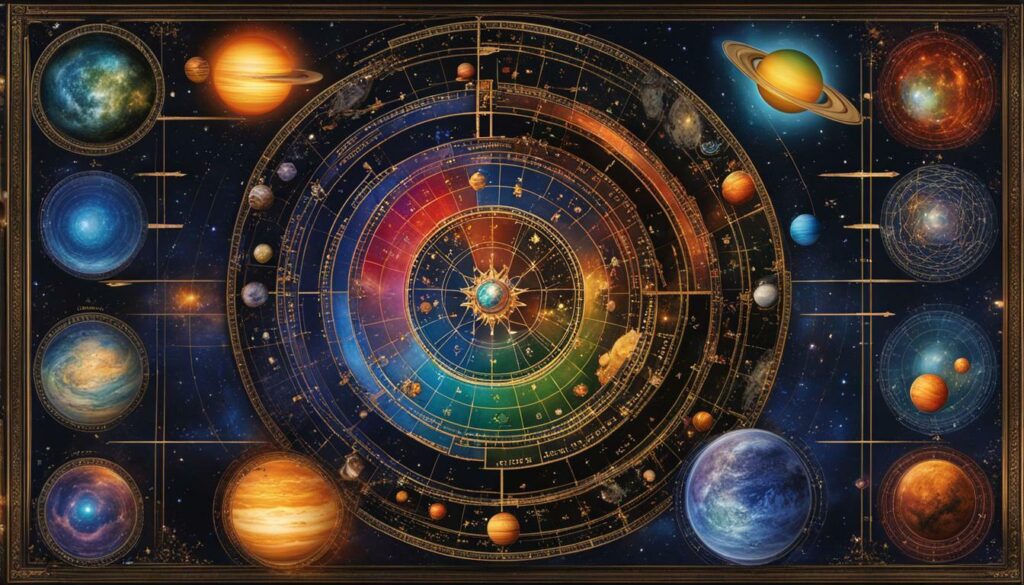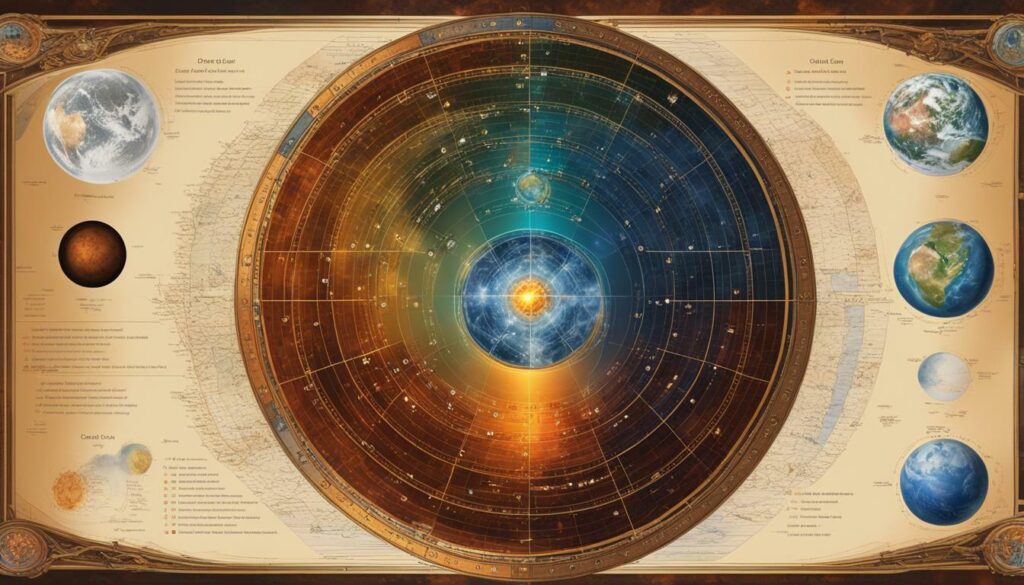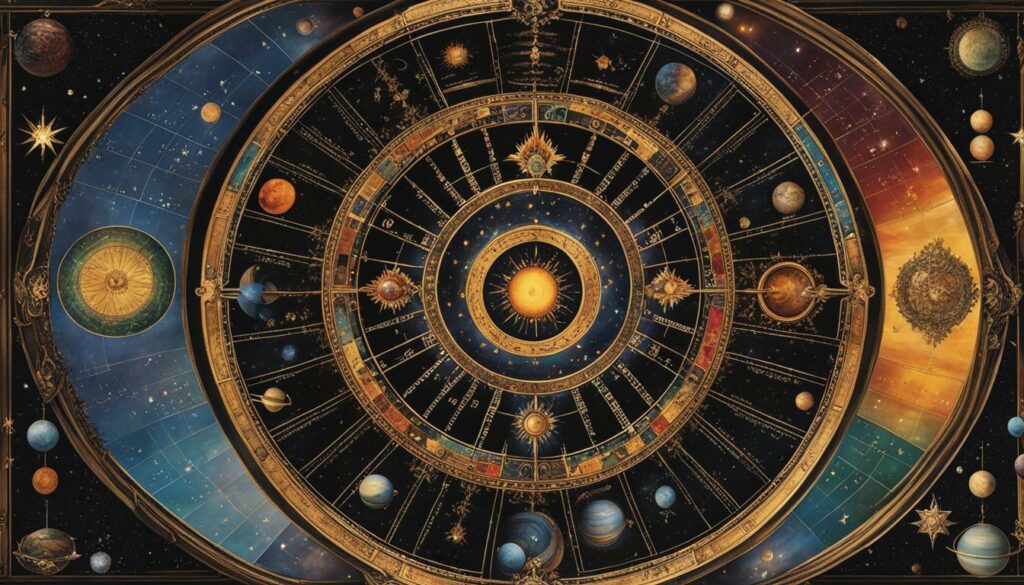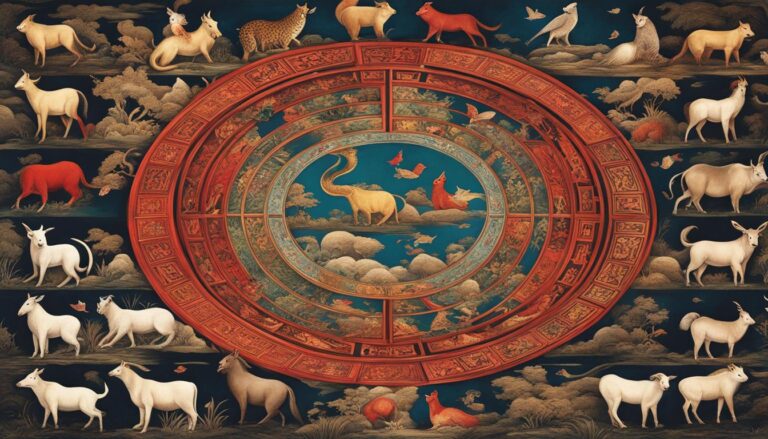Discovering the D30 Chart in Astrology: What Is It?
The D30 chart, also known as the Trimsamsa chart, holds significant importance in astrology, offering valuable insights into a person’s destiny. This unique divisional chart plays a crucial role in understanding various aspects of an individual’s life and provides deeper insights into their strengths, weaknesses, challenges, and overall spiritual evolution.
The D30 chart is calculated by assigning each planet in the birth chart to a specific Trimsamsa based on its placement in the signs. This chart reveals weaknesses related to the five primordial elements and provides guidance on how to overcome them. It also shows the impact of enemies, misfortune, and difficulties in a person’s life, helping them understand and navigate these challenges.
Interpreting the D30 chart involves considering the relationship between the elements, ruling planets, and guiding deities associated with each element. Understanding these connections aids in accurately interpreting the chart and identifying areas of concern. This chart is particularly significant for female charts as it provides insights into their moral character and plays a crucial role in understanding their life path.
Key Takeaways:
- The D30 or Trimsamsa chart is a divisional chart in astrology used to determine difficulties and weaknesses.
- It reveals weaknesses related to the primordial elements and shows the influence of enemies and challenges.
- Interpreting the D30 chart involves considering the relationship between the elements, ruling planets, and guiding deities.
- It is particularly significant for female charts, providing insights into their moral character and life path.
Understanding the D30 Chart Calculation and Interpretation
Calculating and interpreting the D30 chart involves assigning planets to specific Trimsamsas based on their position in signs. Let’s delve deeper into this process and explore an example for better understanding.
In astrology, the D30 chart is divided into 30 equal parts called Trimsamsas, with each Trimsamsa representing a specific portion of a sign. The first Trimsamsa of each sign is assigned to the ruling planet of that sign. For example, the first Trimsamsa of Aries is assigned to Mars, the ruler of Aries. The subsequent Trimsamsas are assigned in a specific sequence to the other planets based on the degrees of the sign they are placed in.
To illustrate this, let’s consider an example. Suppose a person has their Moon placed at 15 degrees in Taurus. Since Taurus is an even sign, we start the sequence from Venus and count back. In this case, the Moon would be assigned to the sixth Trimsamsa, which is associated with Venus. This indicates that the person may have a strong emotional connection and sensual nature.
Interpreting the D30 chart involves analyzing the strengths and weaknesses of the planets in each Trimsamsa and understanding how they influence different aspects of a person’s life. It helps in identifying areas of strength as well as areas where challenges or difficulties may arise. By analyzing the D30 chart in conjunction with the birth chart, astrologers can gain deeper insights into a person’s life path and make predictions about their future.

Significance of the D30 Chart in Vedic Astrology
In Vedic astrology, the D30 chart holds immense significance as a divisional chart, providing deeper revelations about one’s life journey and destiny. It is an intricate tool that offers valuable insights into the various aspects of an individual’s life, helping astrologers make accurate predictions and provide guidance.
One of the key roles of the D30 chart is to shed light on the challenges and weaknesses that individuals may encounter throughout their lives. By analyzing the planetary positions and their interactions within this chart, astrologers can identify potential obstacles and help individuals navigate through them. This chart acts as a guiding map, unveiling the hidden layers of an individual’s destiny.
The D30 chart is often referred to as the Trimsamsa chart, where each Trimsamsa represents a specific segment of one’s life journey. From health to relationships, career prospects to spiritual growth, this chart provides comprehensive information about a wide range of life domains. By understanding the significance of the D30 chart, individuals can gain a clearer understanding of their strengths, weaknesses, and the path they are destined to follow.
Unveiling Weaknesses and Challenges
The D30 chart in Vedic astrology plays a vital role in highlighting weaknesses and challenges that individuals may face. It helps identify areas of vulnerability, such as health concerns, relationship issues, or financial struggles. By pinpointing these weaknesses, astrologers can offer tailored advice and remedies to overcome these obstacles and achieve a more balanced and fulfilling life.
Exploring Life’s Mysteries
The D30 chart also serves as a key to unraveling the mysteries of life. It provides astrologers with a deeper understanding of the karmic patterns and lessons that individuals encounter throughout their journey. By examining the planetary positions and their interactions within the D30 chart, astrologers can offer profound insights into an individual’s life purpose, spiritual growth, and ultimate destiny.
By gaining a comprehensive view of an individual’s D30 chart, astrologers can assess the strengths and weaknesses, opportunities, and challenges that lie ahead. Armed with this knowledge, individuals can make informed decisions, embrace their strengths, and navigate through life’s ups and downs with confidence and clarity.

The D30 chart uncovers weaknesses and challenges that individuals may encounter throughout their lives, shedding light on their ability to overcome adversities. This divisional chart in astrology provides valuable insights into the influence of enemies and how a person deals with misfortune and difficulties.
To analyze the D30 chart, it is essential to understand the association between the planets and the weaknesses they represent. For example, Mars signifies anger, Mercury represents jealousy, Venus indicates lust, Saturn symbolizes intoxication, Rahu signifies greed, and Ketu represents illusion. By examining the placement and aspects of these planets in the chart, astrologers can identify potential areas of weakness.
Interpreting the D30 chart also involves considering the relationship between the elements and the ruling planets associated with each tattva. Understanding the impact of these elements on an individual’s life can provide valuable insights into their strengths and weaknesses. Additionally, the D30 chart can reveal the strength or weakness of the six sources of weakness, which can manifest as diseases or other troubles in different areas of life.
By recognizing and understanding their weaknesses and challenges through the D30 chart, individuals can take proactive steps towards personal growth and spiritual evolution. Worshiping the deities associated with each tattva can serve as a powerful remedy to overcome these weaknesses and achieve a sense of balance and harmony in life.

- The D30 chart unveils weaknesses and challenges individuals may face.
- Planets in the D30 chart represent specific weaknesses, such as anger, jealousy, and lust.
- Interpreting the chart involves understanding the relationship between elements and ruling planets.
- The D30 chart assists in identifying areas of concern and finding remedies for personal growth.
Understanding the Elements and Planetary Weaknesses in the D30 Chart
Each primordial element in the D30 chart corresponds to a specific weakness represented by a planet, revealing a deeper understanding of one’s inner struggles. By analyzing the relationship between the elements and planetary weaknesses, astrologers can gain valuable insights into an individual’s challenges and areas of growth.
In the D30 chart, the element of fire is associated with the weakness of anger, represented by Mars. This signifies a tendency towards impulsiveness and aggression. The element of earth corresponds to the weakness of jealousy, represented by Mercury. Those with this planetary influence may struggle with feelings of envy and possessiveness.
Water is linked to the weakness of lust, represented by Venus. This indicates a propensity for sensual desire and attachment. The element of air is associated with the weakness of intoxication, represented by Saturn. Individuals influenced by this planetary weakness may face challenges related to addiction or escapism.
The primordial element of ether indicates the weakness of greed, represented by Rahu. This signifies a strong desire for material possessions and a tendency towards obsessiveness. Lastly, the weakness of illusion is associated with the element of ether, represented by Ketu. This planetary influence may lead to a distorted perception of reality and a struggle to find clarity.
Understanding the Elements and Planetary Weaknesses:
- Fire: Weakness of anger, represented by Mars
- Earth: Weakness of jealousy, represented by Mercury
- Water: Weakness of lust, represented by Venus
- Air: Weakness of intoxication, represented by Saturn
- Ether: Weakness of greed, represented by Rahu
- Ether: Weakness of illusion, represented by Ketu
By analyzing the strengths and weaknesses indicated by the elements and corresponding planets in the D30 chart, astrologers can guide individuals towards self-awareness and personal growth. Understanding these planetary influences allows individuals to recognize their inner struggles and take proactive steps towards overcoming them. Through spiritual practices and self-reflection, individuals can find harmony and balance within themselves and achieve a higher level of consciousness.

The D30 chart’s interpretation involves considering the tattvas (elements) and the guiding deities associated with each tattva, offering profound insights into one’s spiritual journey. By understanding the relationship between the tattvas, ruling planets, and guiding deities, individuals gain a deeper understanding of their strengths and weaknesses in different areas of life.
- The first tattva is Agni or fire, represented by the deity Agnidev. It relates to enthusiasm, passion, and transformation. A strong fire element in the D30 chart indicates creativity and leadership qualities, while a weak fire element may suggest a lack of motivation or intensity in pursuing goals.
- The second tattva is Prithvi or earth, associated with the deity Prithvidev. It represents stability, practicality, and grounding. A prominent earth element in the D30 chart indicates a strong sense of responsibility and practicality, while a weak earth element may suggest issues with stability or a tendency to be too materialistic.
- The third tattva is Jala or water, represented by the deity Varunadev. It symbolizes emotions, intuition, and sensitivity. A prominent water element in the D30 chart indicates a strong emotional intelligence and intuitive abilities, while a weak water element may suggest difficulties in connecting with one’s emotions or being overly sensitive.
The guiding deities associated with each tattva
- Fire element (Agni): Agnidev
- Earth element (Prithvi): Prithvidev
- Water element (Jala): Varunadev
The guiding deities associated with each tattva act as spiritual guides and mentors, providing guidance and support in navigating life’s challenges and harnessing one’s innate strengths. By paying homage to these deities and embracing their qualities, individuals can strengthen their connection with the corresponding tattva and find balance in their spiritual journey.

The exploration of the tattvas and guiding deities in the D30 chart opens doors to self-discovery and personal growth. It unveils the intricate connections between the elements, planets, and deities, offering a holistic understanding of one’s spiritual path. By delving into the depths of the D30 chart, individuals can embark on a transformative journey toward self-realization and inner harmony.
Remember to worship the guiding deities associated with each tattva and seek their blessings to enhance the positive qualities and overcome the challenges depicted in the D30 chart.
The D30 chart holds specific importance for female charts, revealing valuable insights into their moral character and aiding in comprehending their unique life path. In Vedic astrology, the D30 chart, also known as the Trimsamsa chart, is a divisional chart used to delve deeper into a person’s life and destiny.
For female charts, the D30 chart provides a deeper understanding of their nature and personality traits. It sheds light on their moral character and helps astrologers interpret the challenges and strengths they may encounter in their lives. By analyzing the D30 chart, astrologers can gain insights into a woman’s spiritual journey, her relationships, and her overall life path.
Aiding in Identifying Life Challenges
The D30 chart for female charts serves as a valuable tool in identifying potential challenges and weaknesses that women may face. It can reveal areas of concern in the Rasi chart, such as health issues, conflicts in relationships, or difficulties in career. By understanding the planetary positions in the D30 chart, astrologers can provide guidance and remedies to navigate through these challenges and turn them into opportunities for growth and self-improvement.
The D30 chart for female charts is a powerful resource for astrologers and individuals seeking a deeper understanding of themselves and their life’s purpose. By analyzing this chart, one can gain valuable insights into their moral character, inherent strengths, and areas of growth. It helps individuals navigate through life’s challenges and make informed decisions that align with their true potential and spiritual evolution.

Identifying Areas of Concern in the Rasi Chart through the D30 Chart
By utilizing the D30 chart, one can identify areas of concern in the Rasi chart and gain deeper insights into the impact of planets placed in specific houses. The D30, also known as the Trimsamsa chart, provides valuable information about the weaknesses and challenges individuals may face in different areas of life.
In the D30 chart, the influence of planets in the sixth, eighth, and twelfth houses of the Rasi chart becomes more apparent. These houses are traditionally considered challenging and indicate potential obstacles or difficulties that individuals may encounter. By analyzing the placement of planets in these houses within the D30 chart, astrologers can identify specific areas of concern in the Rasi chart.
For example, if the D30 chart reveals that the planet Mars is placed in the eighth house of the Rasi chart, it suggests that there may be issues related to power struggles, transformations, or sudden changes in that area of life. Similarly, if Saturn is placed in the twelfth house, it may signify potential limitations, isolation, or sacrifices in the corresponding area of life.
Significance of the D30 Chart for Identifying Weaknesses
The D30 chart also helps identify weaknesses in various aspects of life based on the primordial elements associated with specific planets. Each planet represents a different weakness, such as anger, jealousy, or greed. By analyzing the placement of these planets in the D30 chart, astrologers can gain insights into potential areas of vulnerability for individuals.
For instance, if the D30 chart reveals that Mars is placed in a particular Trimamsa, it suggests that the individual may have a propensity towards anger or aggression. Similarly, if Venus is placed in a particular Trimamsa, it may indicate a potential weakness related to lust or indulgence. By recognizing and addressing these weaknesses, individuals can work towards personal growth and spiritual development.

The D30 chart is a powerful tool in Vedic astrology that allows individuals to gain a deeper understanding of their strengths and weaknesses. By studying this chart, astrologers can help individuals navigate through life’s challenges and make informed decisions. It provides valuable insights into areas of concern in the Rasi chart and offers guidance on how to overcome potential obstacles. With the help of the D30 chart, individuals can embark on a path of self-improvement and spiritual evolution.
Conclusion
The D30 chart in astrology holds immense significance in unraveling the mysteries of one’s destiny, providing valuable insights that aid in self-discovery and spiritual growth. This divisional chart, also known as the Trimsamsa chart, reveals various kinds of difficulties and weaknesses that individuals may face, shedding light on their ability to deal with challenges and misfortunes.
By calculating the D30 chart, assigning planets to specific Trimsamsas based on their placement in signs, individuals can gain a deeper understanding of their weaknesses related to the primordial elements. Each weakness is represented by a ruling planet, allowing individuals to recognize and overcome their limitations in areas such as anger, jealousy, lust, intoxication, greed, and illusion.
Interpreting the D30 chart involves considering the relationship between the elements, ruling planets, and guiding deities associated with each tattva. Additionally, the chart helps identify areas of concern in the Rasi chart, indicating the impact of planets in the sixth, eighth, and twelfth houses. This information enables individuals to make informed decisions and find remedies for their weaknesses, leading to a more balanced and harmonious life.
For female charts, the D30 chart plays a crucial role in understanding their moral character. It provides valuable insights into their life path and aids in their spiritual journey. By contemplating the significance of the D30 chart and worshiping the deities associated with each tattva, individuals can achieve personal growth, spiritual evolution, and liberation from material limitations.
FAQ
Q: What is the D30 chart in astrology?
A: The D30 or Trimsamsa chart is a divisional chart in astrology that is used to determine various kinds of difficulties and weaknesses that a person may face.
Q: How is the D30 chart calculated?
A: The D30 chart is calculated by assigning each planet in the birth chart to a specific Trimsamsa based on the degrees of the sign it is placed in.
Q: What does the D30 chart reveal?
A: The D30 chart reveals weaknesses related to the five primordial elements and shows the influence of enemies and how a person deals with misfortune and challenges.
Q: What are the planetary weaknesses in the D30 chart?
A: Planetary weaknesses in the D30 chart include Mars for anger, Mercury for jealousy, Venus for lust, Saturn for intoxication, Rahu for greed, and Ketu for illusion.
Q: How does the D30 chart help in interpreting astrology?
A: The D30 chart helps in interpreting astrology by considering the relationship between the elements, ruling planets, and guiding deities associated with each element.
Q: What is the significance of the D30 chart for female charts?
A: The D30 chart is particularly significant for Female charts as it provides insights into their moral character.
Q: How does the D30 chart identify areas of concern in the Rasi chart?
A: The D30 chart can be used to identify areas of concern in the Rasi chart by determining the impact of planets in the sixth, eighth, and twelfth houses.







